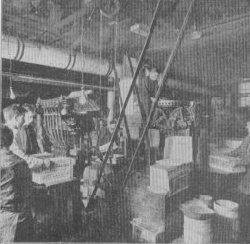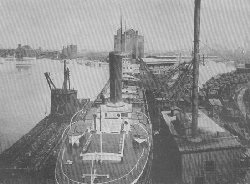|
America, with its great mountains of iron ore, furnishes most of the steel of the world for bridges, high office buildings, railway rails, wire, and the manifold forms of steel and iron which, commercially bring thousands of dollars to the manufacturers. Let us see how crude iron ore changes its shape and quality at the hands of man.
The cupola is the vertical, cylindrical-shaped furnace, in which the iron is melted from "pig" or to be cast in the sand molds, into all of the different forms and shapes taken by cast iron. The real bottom of the cupola is made of sand, and this sand bottom rests on a false bottom which is made of iron, and so swings on heavy hinges that it may be dropped, emptying the cinders on the floor of the foundry. This false bottom is held in place by a heavy piece of wood, which stands on the solid foundation that supports the legs of the cupola. The "tap-hole" of the cupola is the opening through which the molten metal runs into the "spout" and then into the ladle. It is generally about four feet above the floor of the foundry, for it must be high enough to clear a large ladle, to catch the iron. In the back of the cupola is the cinder hole. This hole is used to tap the cinder and to give the alarm should the molten metal rise to the "tuyere" line. "Tuyeres" are the openings for admitting the air blast into the cupola, and they are generally placed high enough from the bottom to give a bed of molten metal, weighing from 1,500 to 2,000 pounds. The air, driven by a revolving fan, is carried to the cupola through the blast pipe. Around the base of the cupola and on a line with the tuyeres, is the "wind box," which carries the blast to the tuyere openings. The "charging floor" is a platform on which the coke, pig iron and scrap iron are piled, and on which the men stand when charging the cupola. The pig iron is usually broken into short pieces to facilitate handling, and to expose more surface to the heat.
Chemically pure iron is of no value to the foundryman, and it is of most use when mixed in certain quantities with metalloids such as manganese, carbon, silicon, sulphur and phosphorus. Carbon should exist in iron mixes to about 3 per cent. Sulphur should be present in very small quantities, and when there is too much in the mix, lime is mixed with the iron and coke in the cupola. The limestone takes up the superfluous sulphur, and renders the iron more fit for molding. In making pig iron direct from the iron ore, much the same principle Is used as just described. In that work, however, the ore, limestone and coke are placed in the cupola instead of the iron refined. When the supply of molten metal in that case is sufficient for a flow, the plug is knocked out of the tap-hole, and the molten metal runs out into a sand floor into "pigs." The sand floor has been prepared in long troughs, not unlike plowed furrows, and when the hot metal has been run into them the sand is thrown over the top to help congeal it. In order to make the pigs in a form that can be handled readily, workmen walk about over the top of this hot bed of metal, their feet protected from the heat by great wooden shoes, or blocks of wood tied to the shoes, and with long handled hammers, strike the bars of cooling metal, breaking them up into convenient form for shipment. Sometimes the pig-iron mill is adjacent to the steel rolling mills, and in that event it is desirable to roll the metal while it is yet hot and thus save reheating. This is done by taking the liquid metal in little brick or clay line-carts or ladles to the great steel mixing blasts. These are like immense cupolas without any cover. The iron is poured into these great upright cylinders, with a quantity of "spiegel iron." This is a combination of metalloids mentioned before, being principally carbon, to give a certain quality of brittleness. The more carbon is mixed with iron, the more brittle it is. When the mix is proper and the combination has been blasted by a fierce blaze, it is run off into great ingots. When these ingots have been cooled a little, but are yet very hot and red, they are carried about through the different processes of manufacture. If it is steel rails that are to be made, the ingots are thrown into great series of heavy rollers, which reduce the width and thickness of the billets but lengthen them out and shape them properly. By the time the steel is cool, they are straightened and complete for doing their part in great railways for the transportation of the world's products. SILK COCOONS, AND THE SILK INDUSTRY |

